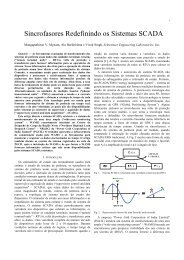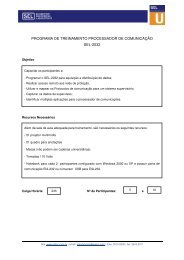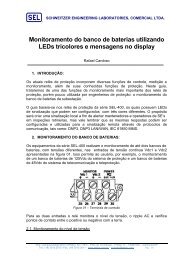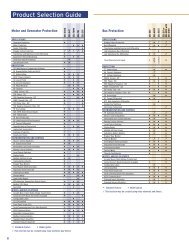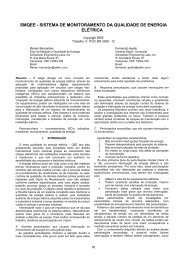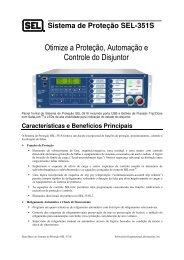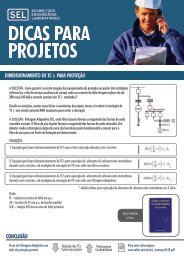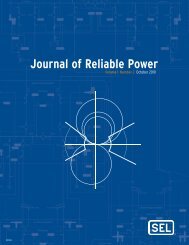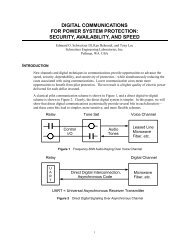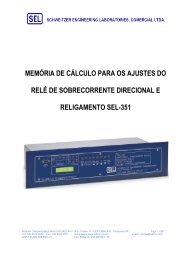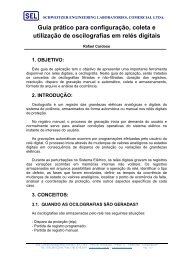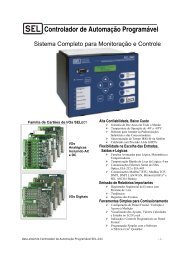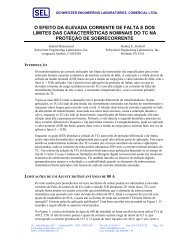Journal of Reliable Power - SEL
Journal of Reliable Power - SEL
Journal of Reliable Power - SEL
You also want an ePaper? Increase the reach of your titles
YUMPU automatically turns print PDFs into web optimized ePapers that Google loves.
The receiver amplifier is the major source <strong>of</strong> noise in the<br />
system—and that noise source is very small compared to the<br />
large signals used in simple, practical systems. The received<br />
signal strength is the transmit power minus attenuation.<br />
Attenuation in decibels is proportional to fiber length plus<br />
some loss for each connection or splice. A system designer<br />
usually fixes the transmit power at some level, specifies a<br />
power margin, and then guarantees some allowable fiber<br />
length at some maximum bit-error-rate or BER. If we use less<br />
fiber or fewer connections, there is more signal power at the<br />
receiver, and the BER decreases.<br />
Suppose the system designer chose a maximum allowable<br />
BER <strong>of</strong> 10 -9 at some maximum allowable fiber length.<br />
Figure 3 was adapted from [4]. It shows that decreasing the<br />
fiber length by 40% in such a system (to 0.6 per unit),<br />
decreased the BER from 10 -9 to about 10 -23 , a decrease <strong>of</strong> 14<br />
orders <strong>of</strong> magnitude! Random bit errors cease to be an<br />
important source <strong>of</strong> unavailability.<br />
Unavailability then becomes dominated by other factors<br />
such as fiber breaks, misapplications, etc. Therefore, welldesigned<br />
fiber-optic communications systems will result in<br />
long periods <strong>of</strong> error-free performance separated by complete<br />
outages caused by human factors or equipment failure.<br />
BER<br />
Figure 3<br />
Bit Error Rate vs. Normalized Fiber Length<br />
10 -10<br />
10 -15<br />
10<br />
-25<br />
10<br />
0.5 0.6 0.7 0.8 0.9 1 1.1 1.2<br />
10 -5 Fiber Length (1.0 at BER=1.0E-9)<br />
Conservative Designs Yield Near-Zero BER on Fiber Links<br />
Does this mean we can ignore communications security<br />
No. Consider what happens to a fiber-optic receiver when a<br />
user disconnects one end <strong>of</strong> the fiber while the link is in<br />
service. The disconnection process is slow compared to most<br />
fiber-optic data transfer rates. As the user draws the fiber<br />
away from the receiver, attenuation increases and ambient<br />
light begins to flood the receiver. This causes the bit error rate<br />
to increase until the received bit stream is essentially all noise.<br />
The receiving device must recognize this noise and reject the<br />
corrupted data, or a misoperation may result. The security<br />
built into the 36-bit message described earlier is sufficient to<br />
ensure less than a 10 -7 chance that disconnecting the fiber<br />
could cause an undetected error. A security counter <strong>of</strong> just two<br />
virtually eliminates the risk, even for direct tripping.<br />
Can direct fiber channels be affected by faults There is<br />
some risk that the physical event which breaks the fiber could<br />
cause the fault, such as a tower collapse or static wire failure<br />
where the fibers are in the static wire. Tornadoes, ice loading,<br />
or an airplane collision are also possibilities. Even then, there<br />
is some chance the message will get through to permit the<br />
scheme to work, after the fault occurs and before the channel<br />
is destroyed.<br />
When a dedicated fiber is closely associated with the power<br />
line right-<strong>of</strong>-way, the probability that an external fault will<br />
cause a communications disturbance is negligible.<br />
B. Multiplexed Fiber<br />
Fiber-optic multiplexers combine many relatively slow<br />
digital and analog channels into one wideband light signal.<br />
The multiplexer, therefore, makes efficient use <strong>of</strong> bandwidth<br />
in the fiber. A direct digital connection between the relay and<br />
the multiplexer is more reliable and economical than<br />
interfacing through conventional relay contacts, then a tone<br />
set, and into an analog channel on the multiplexer. The<br />
multiplexer adds a level <strong>of</strong> complexity, which can be avoided<br />
by the simple dedicated fiber approach discussed earlier.<br />
C. Fiber-Optic Networks<br />
Wide-area networks, such as SONET, move large<br />
quantities <strong>of</strong> data at high speed. Many such networks consist<br />
<strong>of</strong> self-healing rings.<br />
Since the self-heal time is long compared to expected<br />
protective relay tripping times, we must still be concerned<br />
with correlation between faults and communications<br />
problems.<br />
There is a trade<strong>of</strong>f between long-term availability and<br />
short-term dependability. The ring self-heals so that<br />
communications are rarely totally lost. However, a failure<br />
anywhere in the network results in a short communications<br />
loss. <strong>Power</strong> Networking [5] describes a cascaded ring<br />
topology that reduces the exposure to these short interruptions.<br />
While the ring is self-healing, the terminal equipment is<br />
generally not. Thus the terminal equipment, and possibly other<br />
points, must be considered as possible single points <strong>of</strong><br />
failure—even though we have a self-healing ring.<br />
D. Multiplexed Microwave<br />
Microwave systems have gone digital, too—opening new<br />
opportunities for direct relay-to-relay communications. (Later<br />
we describe a low-delay modem, which can be used to transfer<br />
digital information through analog microwave channels, with<br />
the quality required for pilot protection.)<br />
Microwave equipment failures include multiplexers, radio<br />
gear, antenna pointing errors, cabling, etc. Microwave<br />
communications are fairly immune to power system faults. In<br />
general, the likelihood <strong>of</strong> a communication failure for an<br />
internal fault is not much different from the likelihood <strong>of</strong> a<br />
failure for an external fault.<br />
E. Narrow-Band UHF Radio<br />
Dedicated radios have been used for pilot channels.<br />
Reference 1 describes how a 960 MHz radio link was used in<br />
a POTT scheme. The radio was purchased with a single on<strong>of</strong>f-keyed<br />
tone interface between the radio and the relay<br />
Digital Communications for <strong>Power</strong> System Protection: Security, Availability, and Speed | 33




